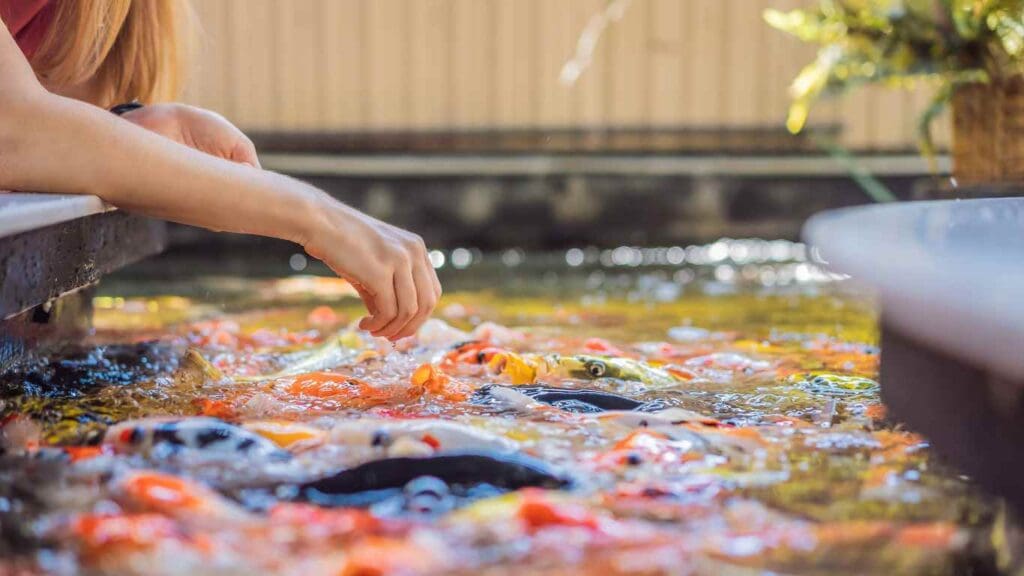If you’re a koi pond owner, you know that feeding your fish is an important part of their care. However, determining how often to feed them can be a bit tricky. Overfeeding can lead to health problems and poor water quality, while underfeeding can stunt their growth and leave them malnourished. So, how often should you feed your koi?
The frequency of feeding your koi will depend on a few factors, including their age, size, and the water temperature. Younger koi need to be fed more frequently than adults, and smaller fish require smaller portions. Additionally, the temperature of the water can affect their metabolism and appetite. In general, it’s recommended to feed your koi 2-4 times a day, but adjust the frequency based on the factors mentioned above.
How Often to Feed Koi in Pond- Key Guidelines:
Understanding Koi Fish
Koi fish are beautiful and popular fish that are often kept in ponds. They are known for their vibrant colors and patterns, and they can grow quite large. If you have a koi pond, it’s important to understand the needs of these fish, including how often to feed them.
Koi fish are omnivores, which means they eat both plant and animal matter. They will eat just about anything, from small bugs and insects to plants and algae at the bottom of the pond. However, it’s important to provide them with a balanced diet that includes both protein and vegetation.
Koi fish are also sensitive to water temperature, and their feeding habits can be affected by changes in temperature. In general, they will eat less in colder water and more in warmer water. It’s important to adjust their feeding schedule accordingly.
When feeding your koi, it’s important to avoid overfeeding them. Overfeeding can lead to health problems and can also contribute to poor water quality in the pond. A good rule of thumb is to feed your koi no more than they can consume within five minutes.
In addition to regular feedings, it’s also important to provide your koi with a varied diet. This can include live foods such as worms and insects, as well as commercial koi food. It’s also important to provide them with vegetation such as lettuce or spinach.
Overall, understanding the needs of your koi fish is essential for their health and well-being. By providing them with a balanced diet and adjusting their feeding schedule to match changes in water temperature, you can help ensure that your koi thrive in their pond environment.
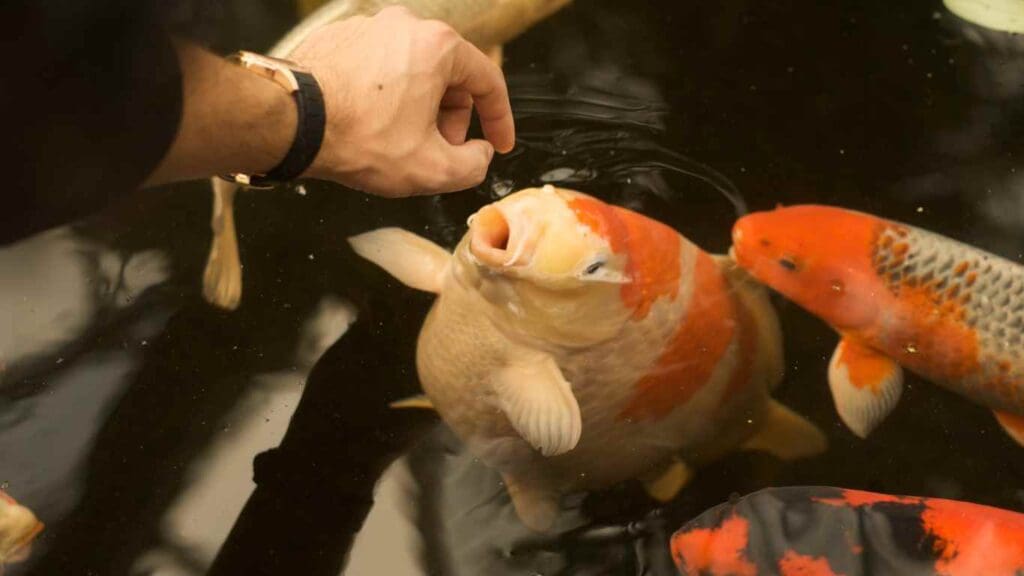

Importance of Feeding Koi
Feeding your koi fish is an essential part of keeping them healthy and happy in your pond. Proper feeding habits can help maintain the overall health of your koi and improve the water quality in your pond. Here are some reasons why feeding your koi is important:
1. Growth and Development
Koi fish require a balanced diet to grow and develop properly. Feeding them a high-quality koi food that contains all the necessary nutrients is essential for their growth and development. Overfeeding or underfeeding can lead to stunted growth, which can affect the overall health and appearance of your koi.
2. Energy and Immune System
Koi fish need energy to swim, play, and maintain their immune system. Feeding your koi with the right amount of food will help them maintain their energy levels and keep their immune system strong. A weak immune system can make your koi more susceptible to diseases and infections.
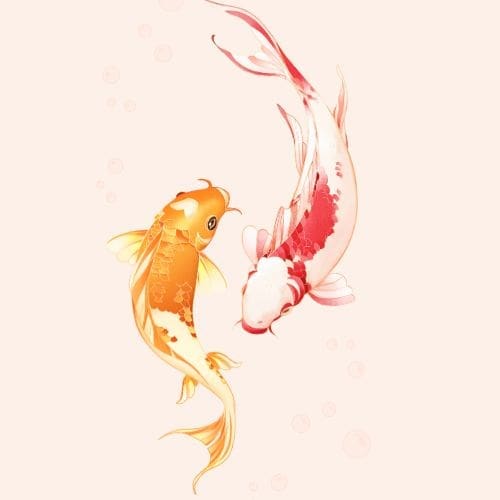

Get the Information You Need Direct from Koi Pond Experts
Join Now!
3. Water Quality
Overfeeding your koi can lead to excess waste, which can negatively impact the water quality in your pond. Poor water quality can lead to health problems for your koi and other aquatic life in your pond. It is important to feed your koi the right amount of food to maintain a healthy balance in your pond.
4. Bonding with Your Koi
Feeding your koi can be a great way to bond with them and observe their behavior. Koi fish are social creatures and enjoy interacting with their owners. Feeding them by hand can be a fun and rewarding experience for both you and your koi.
In summary, feeding your koi is an important aspect of maintaining their health and happiness in your pond. It is important to feed them the right amount of food to promote growth and development, maintain energy levels and a strong immune system, and prevent poor water quality. Bonding with your koi through feeding can also be a rewarding experience.
Determining the Frequency of Feeding
When it comes to feeding koi in your pond, determining the frequency of feeding is crucial for the health and well-being of your fish. Here are some factors to consider when determining how often to feed your koi:
Fish Age
The age of your koi fish plays a significant role in determining their feeding frequency. Juvenile koi fish require more frequent feedings in smaller quantities, while adult koi fish can be fed less frequently. As a general rule, feed your koi 2-4 times a day, which they can consume within 5 minutes.
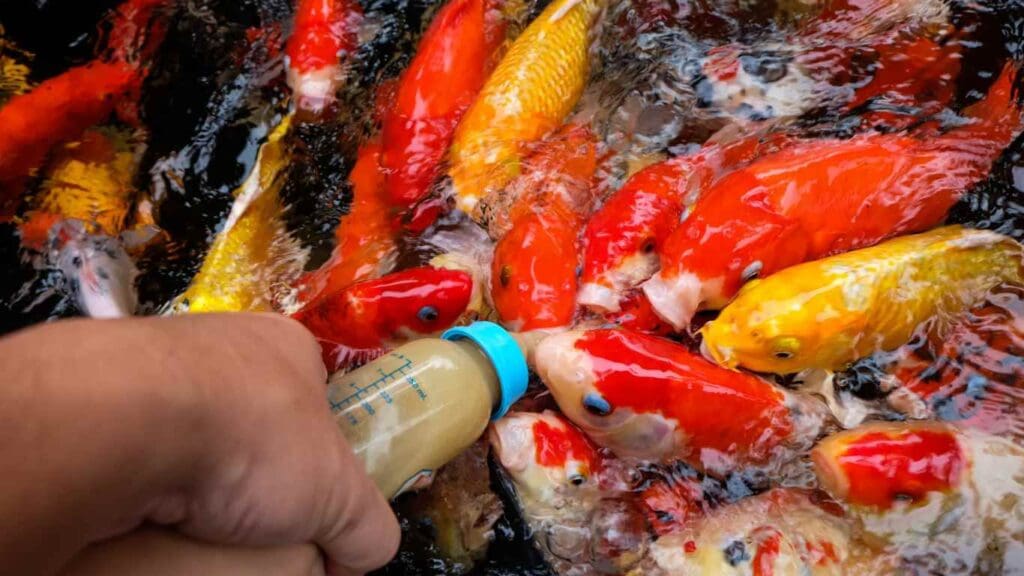

Water Temperature
Water temperature also affects the feeding frequency of koi fish. In colder temperatures, their metabolic rate decreases, and they require less food. As the temperature rises, their metabolism increases, and they require more food. It is recommended to feed your koi 1-2 times a day in warmer temperatures.
Feeding Behavior
Monitoring your koi’s feeding behavior is crucial in determining their feeding frequency. Feed your koi a small amount of high-quality food 2-3 times per day. If they finish the food within 3-5 minutes, you can increase the feeding frequency. If they leave food behind, reduce the feeding frequency.
Feeding Schedule
Establishing a feeding schedule can help regulate the feeding frequency of your koi fish. The table below shows a feeding schedule based on water temperature:
| Water Temperature | Feeding Frequency |
|---|---|
| 72-90°F | 3x daily |
| 65-72°F | 1-2x daily |
| 60-65°F | 1x daily |
In conclusion, determining the frequency of feeding for your koi fish is crucial for their health and well-being. Consider their age, water temperature, feeding behavior, and establish a feeding schedule to ensure your koi are getting the right amount of food.
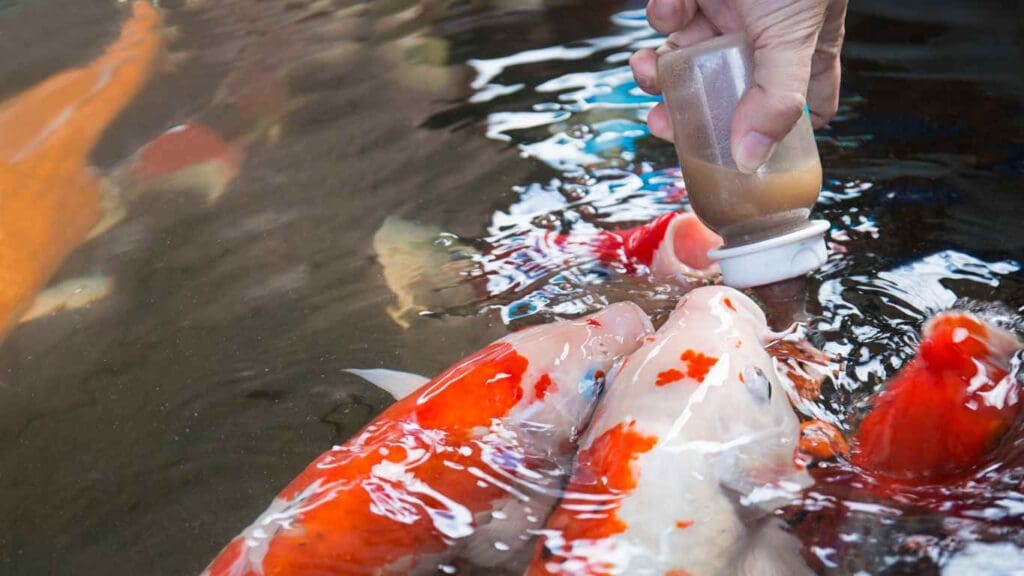

Seasonal Feeding Patterns
Feeding your koi fish in a pond requires a bit of knowledge about their seasonal feeding patterns. As the water temperature changes, so do their appetite and feeding habits. Here are some guidelines to follow for seasonal feeding patterns:
Feeding in Spring
In the spring, when the water temperature is between 50-60°F, you should feed your koi once a day. As the water temperature increases, you can increase the frequency of feeding. When the water temperature reaches above 60°F, you can feed your koi one or two times a day.
Feeding in Summer
During the summer months, when the water temperature is consistently above 60°F, you can feed your koi two or three times a day. However, be careful not to overfeed them. Feed them only what they can consume within 3-5 minutes.
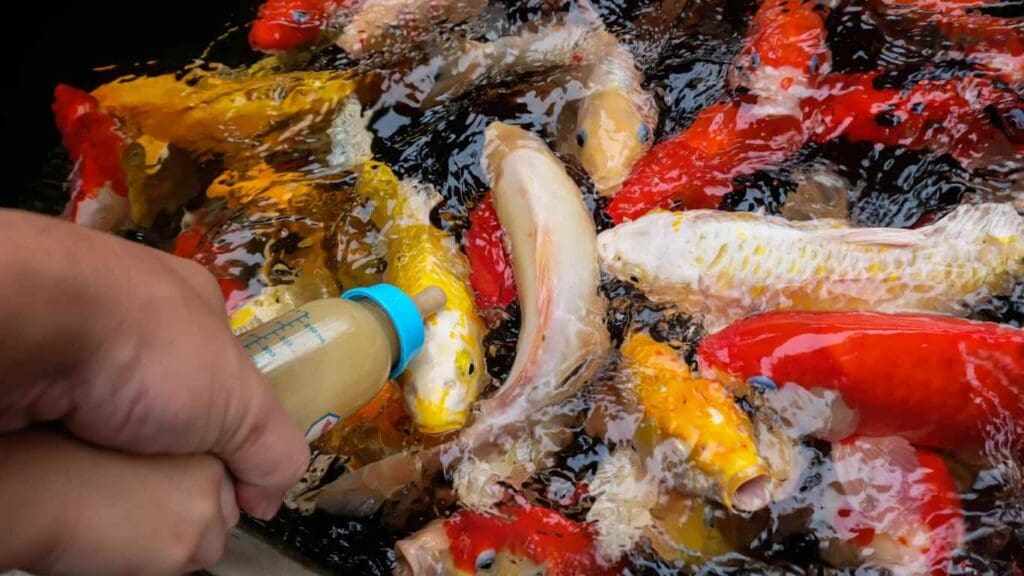

Feeding in Autumn
As the water temperature begins to drop in the fall, your koi’s metabolism slows down, and their appetite decreases. When the water temperature is between 50-60°F, you should feed them once a day. When the temperature drops below 50°F, you can reduce feeding to every other day.
Feeding in Winter
During the winter months, when the water temperature drops below 50°F, your koi will become dormant and stop eating. Do not feed them during this time, as any uneaten food will rot and pollute the water. You can resume feeding them when the water temperature rises above 50°F in the spring.
By following these seasonal feeding patterns, you can ensure that your koi fish are healthy and well-fed throughout the year. Remember to adjust the frequency and amount of food based on the water temperature and your koi’s appetite.
Types of Koi Food
When it comes to feeding your koi, there are a variety of food options available. Here are some common types of koi food:
Pellets
Pellets are a popular choice for koi food. They come in a variety of sizes and are designed to float on the surface of the water. Pellets are a convenient option as they can be stored for long periods of time without spoiling.
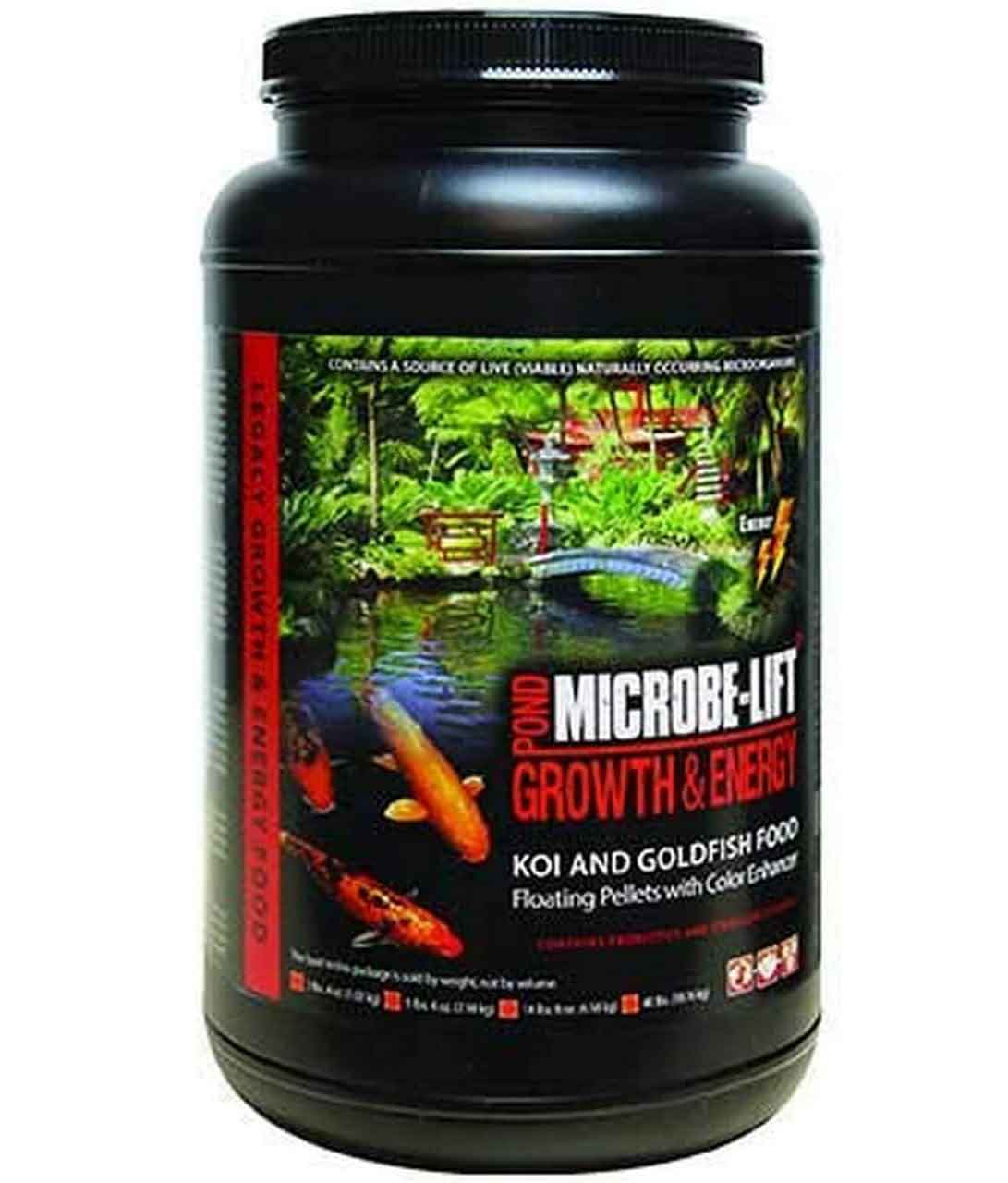

High Growth and Energy Floating Fish Food Pellets for Koi
Flakes
Flake food is another option for feeding koi. It is a good choice for smaller koi as the flakes are small and easy to eat. However, flakes can be messy and may not be as nutritious as other types of koi food.
Freeze-Dried
Freeze-dried food is a popular choice for koi owners as it is easy to store and has a long shelf life. It is also a good option for feeding koi when you are away as it can be left in the pond for several days without spoiling. However, freeze-dried food may not be as nutritious as other types of koi food.
Live Food
Live food is a great option for providing your koi with a more natural diet. Common live foods for koi include worms, shrimp, and insects. However, live food can be expensive and may introduce unwanted pests to your pond.
Homemade Food
Homemade food is a good option for koi owners who want to control exactly what their koi are eating. Homemade food can be made from a variety of ingredients, including vegetables, fruits, and meat. However, it can be time-consuming to make and may not provide all the necessary nutrients for your koi.
When choosing a type of koi food, it is important to consider the nutritional content, the size of the pellets or flakes, and the cost. It is also important to vary your koi’s diet to ensure they are getting all the necessary nutrients.
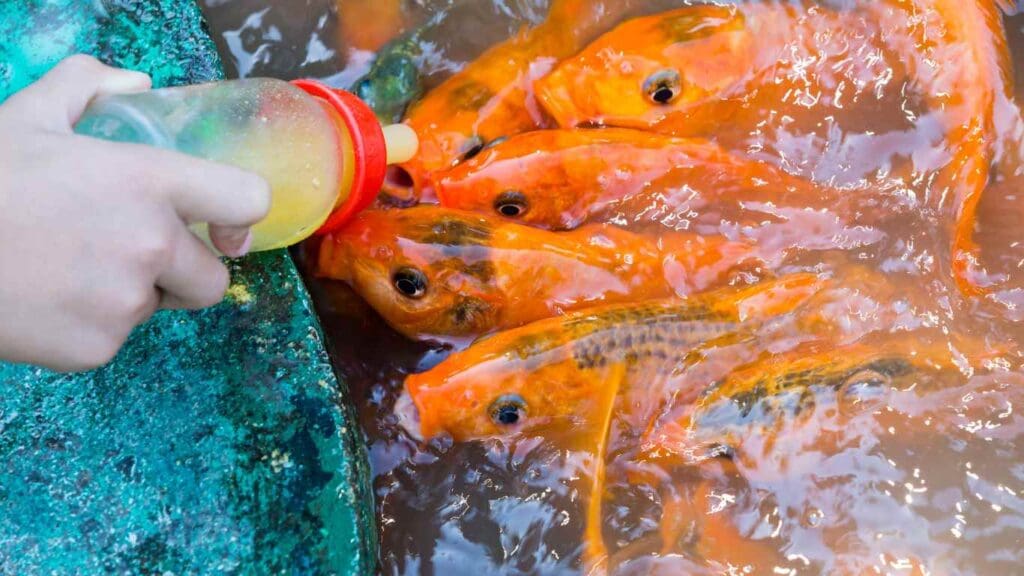

Feeding Techniques
When it comes to feeding your koi, there are a few techniques you can use to ensure they are getting the right amount of food and nutrients. Here are some tips to keep in mind:
Frequency
As a general rule, it is recommended to feed your koi 2-4 times a day. However, this can vary based on factors such as the age of the koi and the water temperature. For juvenile koi, it is best to feed them more frequently in smaller quantities. As the koi matures, they will eat less relative to their body weight and can tolerate fewer feedings.
Amount
A good target amount to feed your koi is 1-4% of their body weight. It is important not to overfeed your koi, as this can lead to health problems such as obesity and poor water quality. Only feed your koi as much as they can consume within 5 minutes.
Kaytee Koi's Choice Koi Floating Fish Food, 10 Pound
$24.95 in stock
Types of Food
Koi can be fed a variety of foods, including pellets, flakes, and live or frozen foods. It is important to choose a high-quality food that is appropriate for your koi’s age and dietary needs. Some koi owners also like to supplement their koi’s diet with treats such as fruits and vegetables.
Feeding Techniques
Here are some feeding techniques you can use to ensure your koi are getting the right amount of food:
- Scatter feeding: Scatter the food across the surface of the pond to encourage natural feeding behavior.
- Target feeding: Use a feeding ring or other device to target feed your koi in a specific area of the pond.
- Hand feeding: Some koi owners enjoy hand feeding their fish, which can help build trust and a bond between you and your koi.
By following these feeding techniques and keeping a close eye on your koi’s behavior and health, you can ensure they are getting the right amount of food and nutrients to thrive in your pond.
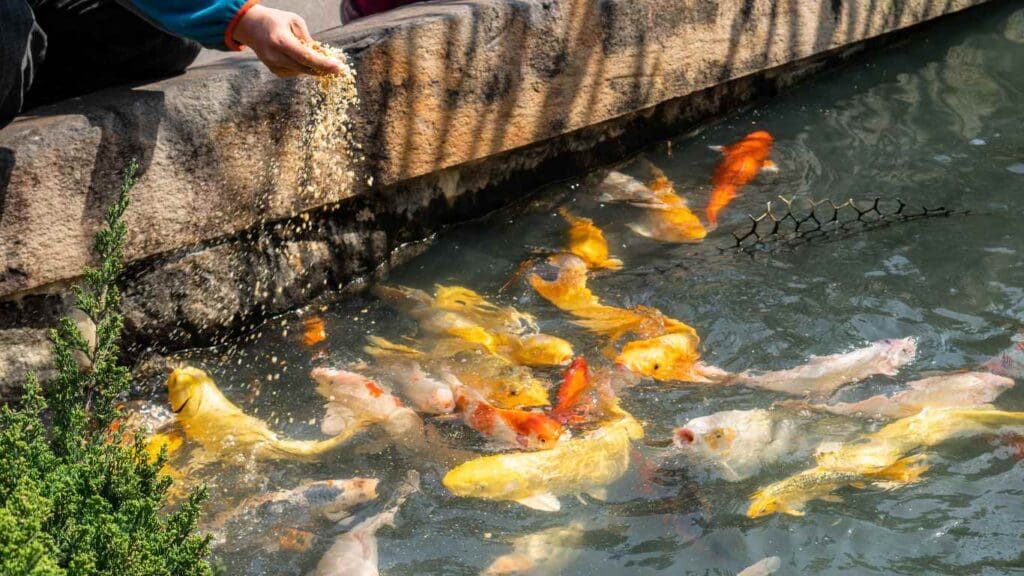

Effects of Overfeeding
Overfeeding your koi can have negative effects on their health and the health of your pond. Here are some of the consequences of overfeeding:
- Increased biological waste in the pond: Overfeeding leads to uneaten food sinking to the bottom of the pond, which can increase the amount of biological waste. This waste can create an unhealthy environment for your koi and other aquatic life in the pond.
- Decline in water quality: Overfeeding can lead to a decline in water quality due to the increased amount of waste. Poor water quality can cause stress to your koi and make them more susceptible to diseases.
- Lowered oxygen content: Overfeeding can lead to a decrease in oxygen content in the pond. Koi require a well-oxygenated environment to thrive, and low oxygen levels can cause stress and even death.
- Damage to kidney and internal organs: Overfeeding can cause damage to your koi’s organs, particularly their kidneys. This can lead to health problems and a decreased lifespan.
- Increased chance for disease onset: Overfeeding can weaken your koi’s immune system, making them more susceptible to diseases and infections.
- Fin rot: Overfeeding can lead to fin rot, a bacterial infection that can cause your koi’s fins to deteriorate.
- Death: Overfeeding can ultimately lead to the death of your koi, particularly if the poor water quality and stress caused by overfeeding goes unchecked.
To avoid these negative effects, it is important to feed your koi the appropriate amount of food based on their body weight and the water temperature. Overfeeding can be tempting, but it is important to resist the urge and prioritize the health of your koi and your pond.
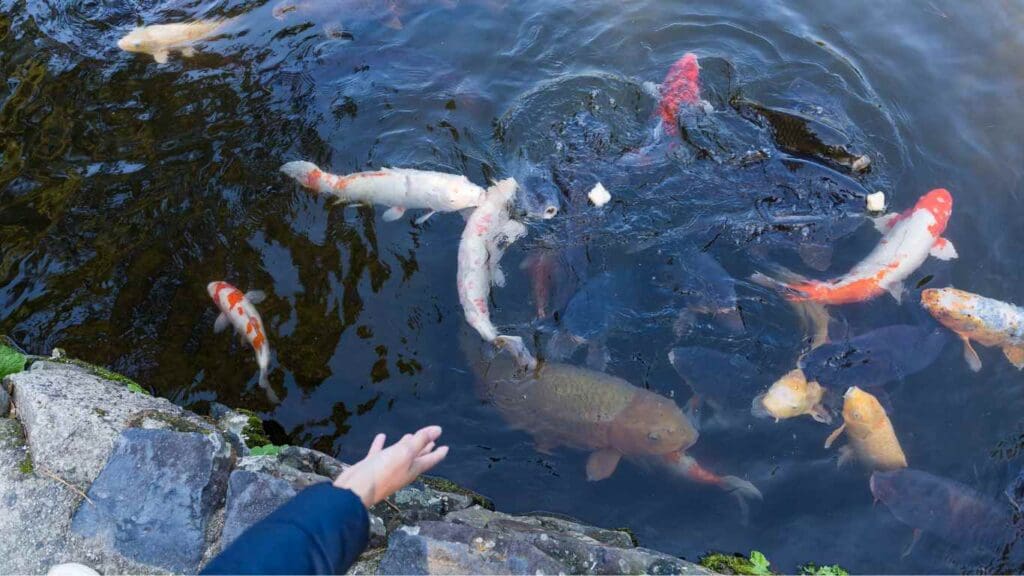

Monitoring Koi Health Through Feeding Patterns
Feeding your koi is not just about providing them with enough food. It is also a way to monitor their health and well-being. By observing their feeding patterns, you can tell if they are healthy or if there is something wrong with them.
Here are a few things to keep in mind when monitoring your koi’s feeding patterns:
- Frequency of Feeding: As mentioned in the previous section, it is recommended to feed your koi 2-4 times a day. If your koi are not eating as much as they used to, it could be a sign of illness or stress. On the other hand, if they are eating too much, it could lead to health problems such as obesity and poor water quality.
- Amount of Food: You should also keep track of how much food your koi are consuming. Overfeeding can lead to health problems, so make sure you are giving them the right amount of food. A good rule of thumb is to feed them an amount that they can consume within 5 minutes.
- Behavior During Feeding: Observe your koi’s behavior during feeding. Healthy koi will be active and eager to eat, while sick or stressed koi may not eat at all or show signs of lethargy. If you notice any unusual behavior during feeding, it may be a sign of a health problem.
- Water Quality: Finally, keep an eye on your pond’s water quality. Poor water quality can affect your koi’s appetite and overall health. Make sure to test your water regularly and take appropriate measures to maintain good water quality.
By monitoring your koi’s feeding patterns, you can catch any health problems early on and take appropriate action to keep them healthy. Remember to observe their behavior during feeding, keep track of the amount of food they consume, and maintain good water quality in your pond.


Get Advice from a Koi Pond Expert – Join our KPE Community!
Final Remarks
In the end, feeding your koi fish in a pond is an important aspect of their care, and it is important to do it correctly. You should feed your koi fish 2-4 times a day, depending on their age and the water temperature. Juvenile koi fish should be fed more frequently in smaller quantities, while mature koi fish will eat less relative to their body weight.
When deciding how much food to give your koi fish, remember that a good target amount is 1-4% of their body weight. You should monitor their feeding behavior and adjust the quantity accordingly. Also, it is important to provide them with a balanced diet that includes both protein-rich food and plant-based food.
Supplementing their diet with live food, such as bloodworms and brine, can also be beneficial. However, make sure to avoid overfeeding your koi fish, as it can lead to health problems and poor water quality in your pond.
Overall, by following these guidelines and providing your koi fish with the proper care and feeding, you can ensure that they thrive in your pond and bring you joy for years to come.
Frequently Asked Questions
How many pellets should I feed my koi fish?
The amount of pellets you should feed your koi fish depends on the size of your fish and the temperature of the water. As a general rule, you should feed your koi fish no more than they can consume within five minutes. For smaller koi fish, start with a small amount of pellets and gradually increase the amount as they grow.
Can koi fish be fed every other day?
Yes, koi fish can be fed every other day, but it’s important to adjust the amount of food you give them accordingly. If you’re feeding your koi fish every other day, you should give them a larger amount of food than you would if you were feeding them every day.
What human food is safe for koi fish to eat?
While koi fish can eat some human foods, it’s important to be cautious and avoid feeding them anything that could be harmful to their health. Safe human foods for koi fish include lettuce, peas, and watermelon. Avoid feeding them anything that is high in sugar, salt, or fat.
What is the best food for koi fish?
The best food for koi fish is a high-quality pellet that is specifically formulated for koi. Look for a pellet that is high in protein and low in fillers. You can also supplement their diet with live or frozen foods such as brine shrimp or bloodworms.
How many times a day should I feed koi fish in a pond?
You should feed your koi fish in a pond 2-4 times a day, depending on the temperature of the water. As a general rule, feed your koi fish more frequently in warmer water and less frequently in colder water.
What is the best time of day to feed koi fish?
The best time of day to feed koi fish is when the temperature of the water is highest, which is usually in the afternoon. Try to feed them at the same time every day to establish a routine.
 1 (509) 228-8646
1 (509) 228-8646


